101 dicas de treinamento para filhotes:o guia definitivo para treinar seu filhote
Treinar um novo filhote pode ser um processo incrivelmente difícil. Entre o treinamento em casa e o treinamento comportamental, um novo filhote é muito parecido com um trabalho em tempo integral. Quando você combina esse trabalho com seu trabalho real trabalho, você pode encontrar-se na extrema necessidade de alguns atalhos. Sem mencionar o quanto o processo pode ser mais difícil se o seu novo cão tiver algum tipo de trauma passado que o torne atípico – mesmo algo aparentemente tão simples quanto uma personalidade particularmente teimosa pode complicar as coisas.
Se você está lutando para treinar seu filhote para se encaixar em sua casa e seu estilo de vida, então você está no lugar certo. Compilamos uma lista de 101 dicas e truques para treinar seu filhote, abrangendo tudo, desde domesticação a treinamento de obediência, treinamento em caixa e almofadas de treinamento para filhotes, além de links para os principais vídeos de treinamento, guias, produtos e tudo o que você precisa para faça com que seu novo filhote se adapte bem ao seu estilo de vida e rotina.
Neste artigo
Filhote de treinamento penico
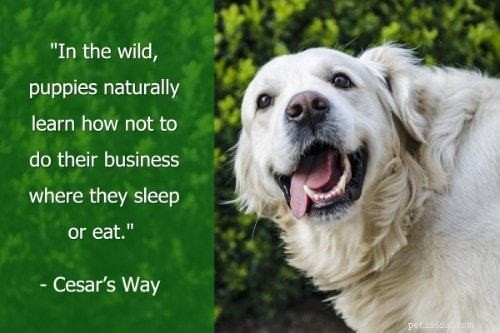
1. É natural. “Em teoria, não deveria ser tão difícil. Na natureza, os filhotes aprendem naturalmente a não fazer suas necessidades onde dormem ou comem. Eles aprendem isso porque sua mãe mantém a toca limpa, imediatamente se livrando de qualquer bagunça que seus filhotes façam. Sem esse cheiro por perto, os filhotes não associam a área a se aliviar.” – Banico treinando um cachorrinho , Caminho de César; Twitter: @cesarmillan
2. Faça um cronograma. “Isso é vital para o sucesso do housetraining. Os filhotes têm bexigas minúsculas, e a água passa por elas. O mesmo vale para a matéria sólida. Entra. Sai. Você precisa ter certeza de que está dando ao seu filhote uma ampla oportunidade de fazer a coisa certa.” – Mara Bovsun, Como treinar um cachorrinho:um guia completo para o sucesso , American Kennel Club; Twitter: @akcdoglovers
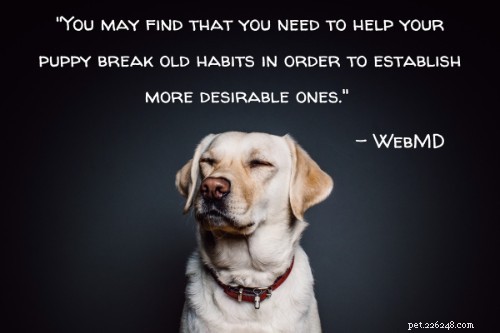
3. Não espere o impossível. “A primeira coisa a entender é que um filhote não tem controle sobre os músculos de eliminação antes dos quatro meses de idade, e todos os filhotes variam no tempo de desenvolvimento desses músculos. Cães menores têm bexigas menores e precisarão urinar com mais frequência”. – Estelle W., Treinamento de filhotes:o que você precisa saber para uma dona de casa bem-sucedida , Animais Encontrados; Twitter: @FoundAnimalsOrg
4. Eles vão atrás de cada… “Leve-os para fora imediatamente após acordar, durante e depois de brincar e depois de comer e beber.” – Como adestrar um filhote de cachorro, Lugar mais seguro para filhotes; Twitter: @SaferPups

5. Fator em seus arranjos anteriores. “As condições de vida anteriores do seu cachorro são outro preditor. Você pode achar que precisa ajudar seu filhote a quebrar velhos hábitos para estabelecer outros mais desejáveis”. – Casa treinando seu filhote , WebMD; Twitter: @WebMD
6. A primeira semana é a mais difícil. “A primeira semana de treinamento de um filhote no banheiro é cansativa, mas fica mais fácil, eu prometo. Você pode se perguntar por que decidiu começar com um filhote de cachorro - confie em mim, todos nós já estivemos lá. Mas depois dessa primeira semana vai ficar mais fácil.” – Jen Gabbard, 5 dicas simples para treinar seu filhote no banheiro , Vazamentos Do Filhote; Twitter: @puppyleak

7. Lembre-se que cães não são humanos. “Na minha experiência, uma das principais razões pelas quais o treinamento doméstico falha é porque os pais de cães tendem a olhar para seus companheiros caninos como humanos de quatro patas. Eles veem os acidentes com animais de estimação no chão da mesma forma que veriam uma pessoa que se alivia no chão. Embora seu cão seja um membro de sua família, ele não é uma pessoa, e se você lidar mal com os erros do penico em casa, muitas vezes você obterá o resultado oposto do que deseja e piorará a situação. ” – Dra. Karen Becker, Evite esse erro – frustra quase todas as tentativas de treinar seu filhote em casa , Animais Saudáveis; Twitter: @drkarenbecker
8. Use almofadas de cachorro para 'só por precaução' “Embora as almofadas de cachorro sejam muito úteis para conter aquelas pequenas bagunças inevitáveis nos primeiros meses de vida do seu cachorro, você não quer que seu cão desenvolva o hábito de usá-las para ir ao banheiro em vez de esperar até que elas sejam liberadas. lado de fora. A melhor maneira de evitar isso é garantir que alguém possa aparecer em seu cão a cada poucas horas para levá-lo para fora. Dessa forma, as almofadas para filhotes são simplesmente um backup de seu treinamento regular no banheiro.” – James Shore, Como criar um filhote se você trabalha em período integral – não é impossível!, Treinamento de labradores; Twitter: @LabTrainingHQ

9. Peça por ajuda. “Se você tem amigos ou familiares de confiança que possuem cães ou são bons com animais, pense em pedir ajuda. Tente pensar em como você pode tornar o arranjo conveniente para eles, como trazer seu filhote e suas necessidades para a casa deles antes do trabalho. Considere maneiras de oferecer incentivos e vantagens para seu amigo que cuida de cães, especialmente se você não estiver pagando. Tente fazer algo que você sabe que eles vão gostar, como levá-los para jantar fora ou alguma outra atividade toda semana.” – Como cuidar de um cachorro quando você trabalha em período integral , WikiHow; Twitter: @wikiHow
10. Você obtém mais abelhas com mel. “Existe apenas uma metodologia aceitável para treinar um cão de qualquer idade:reforço positivo. Os conselhos tradicionais sugeriam dar um tapa em um cachorro ou esfregar o rosto em seu lixo por erros em casa, mas essas técnicas não fazem nada para tornar o processo de treinamento do penico mais compreensível para seu cão e podem realmente prejudicar seu relacionamento com ele. Lembre-se de que os cães não veem seus resíduos da mesma forma que nós – para eles, fazer xixi e cocô é muito interessante! Punir seu cão por entrar em casa não o ajudará a entender o que ele deve fazer e pode deixá-lo com medo de se aproximar de você, por dentro ou por fora. O treinamento bem-sucedido do penico requer paciência, gentileza e lembrar que seu novo filhote está apenas aprendendo as regras.” – Victoria Schade, Como treinar seu cachorro no penico , PetMD; Twitter: @petMD
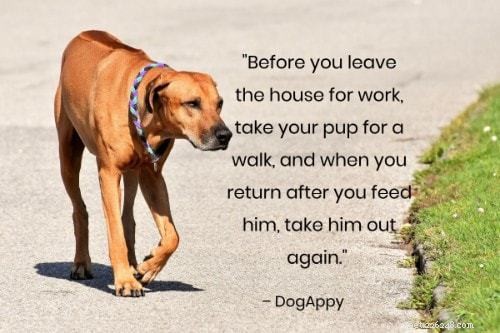
11. Antes de deixar o seu cachorro, prepare-o. “Antes de sair de casa para o trabalho, leve seu cachorro para passear e, quando voltar depois de alimentá-lo, leve-o para passear novamente.” – Como treinar um filhote de cachorro quando você trabalha o dia todo , DogApp
12. Acidentes acontecem. “Erros acontecem. Espere que seu filhote tenha alguns acidentes em casa – é uma parte normal do treinamento doméstico […] Não castigue seu filhote por fazer cocô em casa. Se você encontrar uma área suja, é tarde demais para administrar uma correção. Basta limpá-lo. Esfregar o focinho do seu cachorro nele, levá-lo ao local e repreendê-lo ou qualquer outra punição só fará com que ele tenha medo de você ou medo de eliminar na sua presença. A punição muitas vezes fará mais mal do que bem.” – Como treinar seu cão ou filhote , The Humane Society dos Estados Unidos da América; Twitter: @HumaneSociety
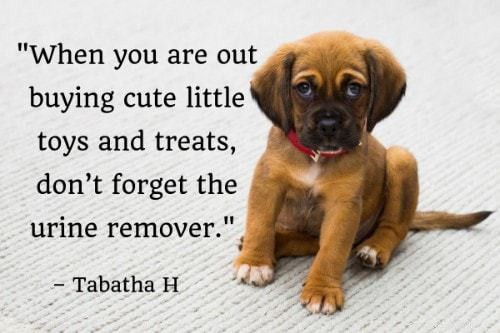
13. Plano para os referidos acidentes. “Quando você está comprando brinquedos e guloseimas fofas, não se esqueça do removedor de urina. Não pense que você pode usar qualquer limpador antigo. Mesmo que você não possa mais sentir o cheiro, seu cão pode. Você precisa de um limpador específico para limpar a bagunça dele, ele vai tirar o cheiro dele também. Um cão continuará a ir onde ele pode sentir o cheiro. Já viu um cachorro farejando o chão ao procurar um lugar para ir? É por isso que, normalmente, ele está procurando um lugar que já esteve antes, ou um lugar que outro cachorro tenha.” – Tabatha H, 5 dicas para cuidar da casa do seu cachorro quando você trabalha em período integral, Dogvills; Twitter: @DogVills
14. Fique de olho nele. “Vigie seu filhote de perto quando estiver em casa com ele para qualquer sinal de que ele precisa sair; isso pode incluir andar de um lado para o outro, arranhar a porta ou choramingar. Leve-o imediatamente para fora e elogie-o quando ele usar o local adequado do banheiro.” – Lori Lapierre, Como cuidar de um cachorrinho se você trabalhar o dia todo , O ninho; Twitter: @TheNest
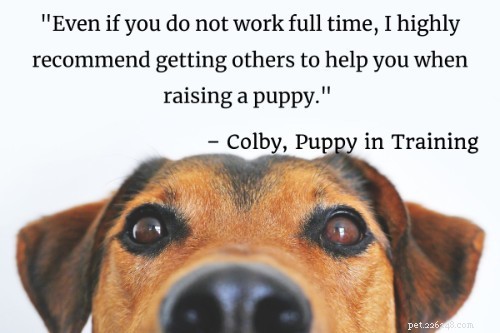
15. Se você trabalha, pode levar uma vila para criar um filhote. “Recomendo trazer uma ou mais […] pessoas para ajudá-lo, mas seu filhote também deve se acostumar a passar algum tempo sozinho durante o dia. Eu teria como objetivo tentar não enjaular seu filhote mais de 1-2 horas duas vezes por dia. Mesmo que você não trabalhe em tempo integral, recomendo que outras pessoas o ajudem ao criar um filhote. Costumo ouvir na comunidade de cães-guia e de serviço:“É preciso uma aldeia para criar um filhote.” A propósito, você não precisará da ajuda de amigos e familiares para sempre. Embora eu tenha certeza de que seu filhote sempre gostará da companhia de pessoas em vez de ficar sozinho, a maioria das pessoas não pode passar tempo com seus filhotes 24 horas por dia, 7 dias por semana.” – Colby, O que você faz com seu cachorro quando trabalha em período integral?, Filhote de cachorro em treinamento; Twitter: @PuppyInTraining
16. Comemore suas vitórias. “Com o desafio adicional de tirar seu filhote de seu apartamento antes que ele vá ao banheiro, é ainda mais importante comemorar cada vitória. Os cães respondem incrivelmente bem ao reforço positivo. Apenas o som da sua voz alegre pode fazer mais para ajudar no treinamento do penico do que as guloseimas jamais poderiam fazer. Nunca castigue ou grite com seu cachorro por ter um acidente dentro de casa. As punições apenas treinarão seu filhote em que você não é confiável e pode levar a problemas de comportamento relacionados à ansiedade. ” – Dina Fantegrossi , O jogo do penico:como treinar seu cachorrinho em um apartamento, AMLI Residencial; Twitter: @AMLIapts
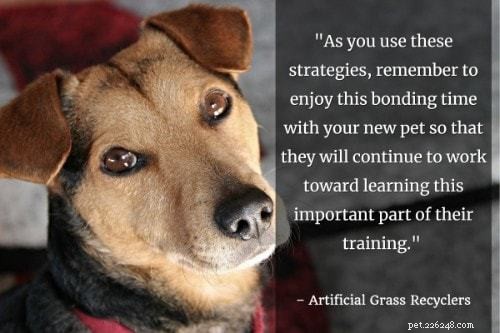
17. Não se esqueça que este também é um momento de união. Você precisa treiná-lo, sim. Mas construir confiança só servirá para facilitar seu treinamento, então não o ignore. “Ao usar essas estratégias, lembre-se de aproveitar esse tempo de vínculo com seu novo animal de estimação para que ele continue trabalhando para aprender essa parte importante do treinamento.” – 7 dicas para treinar um cachorrinho em um apartamento , Recicladores de Grama Artificial; Twitter: @agrecyclers
18. Tome notas. “Durante várias semanas, escrevi tudo. Logo, consegui ver padrões e isso me permitiu ficar à frente de Emily. Por exemplo, todas as noites, por volta das 2 da manhã, ela começava a chorar e se coçar. Quando ela começou a reclamar, já era tarde demais. Então, eu coloquei um alarme para 1:45 e a levei para a rua a tempo. Anotar tudo, inclusive quando ela tinha um esguicho de excitação depois que as pessoas gritavam com ela (o que era frequente), fazia toda a diferença.” – Mara Bovsum, Cachorro grande, cidade grande:como fazer o treinamento em casa funcionar , American Kennel Club; Twitter:@akcdoglovers

19. Recompense-o do jeito que ele quer ser recompensado. “Ofereça elogios e/ou recompensas pelo comportamento desejado. Se o seu cão responde melhor a elogios verbais, a um brinquedo favorito ou a um deleite especial, certifique-se de esbanjar um estímulo positivo toda vez que ele for bem-sucedido no local adequado.” – Stacy Painter, Banico treinando seu cachorrinho quando você mora em um apartamento , Veterinário Preventivo; Twitter: @PreventiveVet
20. No final do treinamento, introduza o sino. “Uma ótima e divertida maneira de treinar seu cão em casa é treiná-lo para se comunicar com você quando ele precisar ir ao banheiro, ensinando-o a tocar a campainha do trem do banheiro. Isso é melhor ensinado depois que seu cão parece preferir sair para ir ao banheiro e você gostaria de dar a ele uma boa maneira de comunicar isso a você. A campainha para cães funciona especialmente bem para cães que têm apenas alguns acidentes ou acidentes perto da porta. Ensinar seu cão a tocar a campainha evita que ele precise recorrer a comportamentos ‘incivilizados’ como arranhar a porta ou latir para dizer para você deixá-lo sair.” – Jess Rollins, Dog Bell Training:Training Your Dog to Ring a Bell to Go Out to Potty, Especialização em Animais de Estimação; Twitter: @PetExpertise
Confira estes recursos e produtos para treinar seu filhote de cachorro:
- Como arruinar seu cachorro em 7 dias (revisado)
- Adestrando seu cão em casa
- Guia definitivo para treinar seu filhote em casa
- Caldwell's Pet Supply Co. Campainhas para cães de adestramento doméstico com potty Bells
- Treinamento para filhotes:como fazer o housebreak seu filhote em apenas 7 dias!
- Bandeja de treinamento para vaso sanitário PUPPYPRO para cachorros
- Guia Completo de TREINAMENTO DE POTTY PARA FILHOTES
- Caminha de campainha Zacro para adestramento de cães e 1 clicker de treinamento
- Aprender a ouvir
Caixa treinando um filhote

21. Entenda o propósito de uma casinha de cachorro. “Os cães são naturalmente animais de toca. Na natureza, a toca de um cachorro é sua casa, um espaço seguro onde ele pode dormir, se retirar e criar filhotes sem medo do perigo, sem ameaças externas. Para um cão domesticado, uma caixa preenche essa necessidade natural de um refúgio seguro. Se introduzido e usado corretamente, a caixa será onde seu cão escolher voluntariamente para dormir, esconder-se quando houver tempestades e, muito possivelmente, deitar-se por nenhum outro motivo além de ser seu próprio espaço. ” – Sara Logan Wilson, Crate Training Your Puppy:The Key To A Pee-Free Home, Revista Canina; Twitter: @CanineJournal
22. Não faça mau uso da caixa. “Uma caixa não é uma solução mágica para o comportamento canino comum. Se não for usado corretamente, um cão pode se sentir preso e frustrado. Nunca use a caixa como punição. Seu cão passará a temê-lo e se recusará a entrar.” – Treinamento de Caixa 101 , Humane Society dos Estados Unidos da América; Twitter: @HumaneSociety
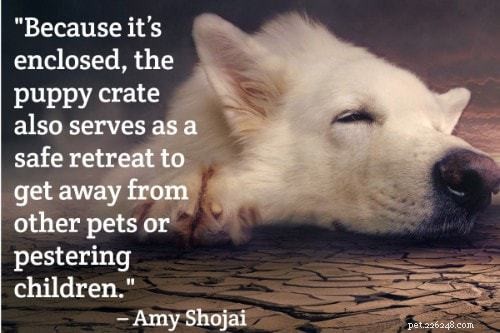
23. Existem alguns grandes benefícios para o treinamento da caixa. “Um caixote funciona bem como uma cama. Por ser fechada, a caixa para filhotes também serve como um refúgio seguro para ficar longe de outros animais de estimação ou crianças importunas. Você não quer um lugar privado onde você não será incomodado? Os cachorros não são diferentes. Uma caixa também pode ser um lugar seguro para confinar aquele cachorrinho indisciplinado. Isso o mantém longe de problemas quando você não consegue observá-lo. Além disso, a maioria dos cães deve ser confinado de vez em quando, quando viajam de carro ou ficam no veterinário, por exemplo. Portanto, conhecer e aceitar uma caixa deve fazer parte do treinamento do seu filhote. É uma das melhores ferramentas disponíveis para ajudar a treinar seu filhote.” – Amy Shojai, Puppy Crate Training, Os animais de estimação Spruce; Twitter: @amyshojai
24. Entenda o processo de treinamento de caixas. “O treinamento na caixa pode levar dias ou semanas, dependendo da idade, temperamento e experiências passadas do seu cão. É importante manter duas coisas em mente durante o treinamento da caixa. A caixa deve estar sempre associada a algo agradável, e o treinamento deve ocorrer em uma série de pequenos passos – não vá muito rápido.” – Como adestrar seu cão na caixa , Patas; Twitter: @PAWStweets
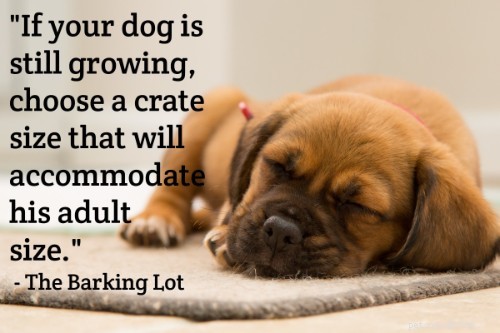
25. Escolha a caixa certa. “A caixa do seu cão deve ser grande o suficiente para ele se levantar e se virar. Se o seu cão ainda estiver crescendo, escolha um tamanho de caixa que acomode seu tamanho adulto. Bloqueie o excesso de espaço da caixa para que seu cão não possa eliminar em uma extremidade e recuar para a outra. Seu abrigo de animais local pode alugar caixas. Ao alugar, você pode trocar até o tamanho adequado para o seu filhote até que ele atinja o tamanho adulto, quando você pode investir em uma caixa permanente.” – Caixas 101:um guia para treinamento em caixas , O Lote Do Latido; Twitter: @TBLTweets
Confira nossas listas das melhores caixas para cães pequenos e as melhores caixas para cães grandes para encontrar a caixa perfeita para o seu filhote.
26. Faça uma introdução adequada à caixa. “Coloque a caixa em uma área familiar da sua casa e deixe a porta da caixa aberta. Deixe guloseimas ou brinquedos dentro e ao redor da caixa, o que incentivará seu cão a explorar dentro da caixa. Essa etapa pode durar alguns dias, dependendo do conforto do seu cão ao encontrar a caixa pela primeira vez. Lembre-se de que dar a um filhote tempo suficiente para se ajustar a cada estágio do treinamento na caixa ajudará todo o processo de treinamento a ocorrer sem problemas.” – Erica Jorgensen, Dicas para treinar um filhote em caixa:não é necessário choramingar , Tratamento Diário; Twitter: @RoverDotCom
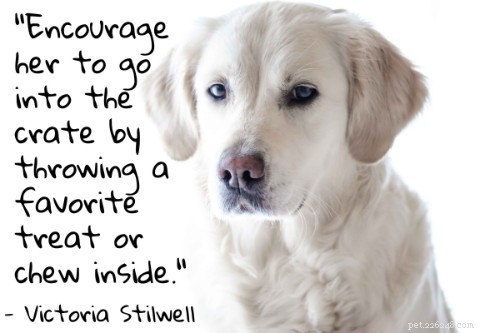
27. Não force seu filhote. “Incentive-a a entrar na caixa jogando uma guloseima favorita ou mastigando dentro. Se o seu cachorro decidir se acomodar, permita que ele faça isso sem fechar a porta para que ele possa tomar sua própria decisão sobre ficar ou sair. Quando ela estiver confortável para entrar na caixa, comece a fechar a porta por alguns segundos de cada vez, aumentando gradualmente a duração enquanto ela estiver relaxada.” – Victoria Stilwell, Treinamento de Caixa , Positivamente; Twitter: @VictoriaS
28. Comece com tempos curtos com a porta fechada. “Você nem tentou fechar a porta com ele dentro. Direito? Isso é importante, pois você quer que ele ame absolutamente entrar na caixa e não fique com medo ou preocupado com a porta. Uma vez que ele tenha isso, você deve estar pronto para começar a fechar a porta. Comece a sessão como você parou, mas desta vez feche a porta da caixa por alguns segundos enquanto ele ainda está comendo as últimas guloseimas que você jogou. Abra a porta da caixa e deixe-o sair antes que ele termine de comer. Repita cerca de três ou quatro vezes. O próximo passo é começar a aumentar gradualmente o tempo que a porta fica fechada, com seu filhote dentro, é claro. Estamos falando de segundos e não de minutos, então é muito lento. Coloque algumas guloseimas na caixa enquanto a porta está fechada para que ele fique feliz. Não vá embora e deixá-lo neste momento. Adicionar um brinquedo favorito ou um Kong de pelúcia o manterá ocupado. Também ajudará a acelerar o processo de treinamento do seu filhote na caixa se você alimentar as refeições na caixa.” – Sharon, Crate treinando um filhote , Conhecimento de Cuidados com Cães; Twitter: @Dogcareknow
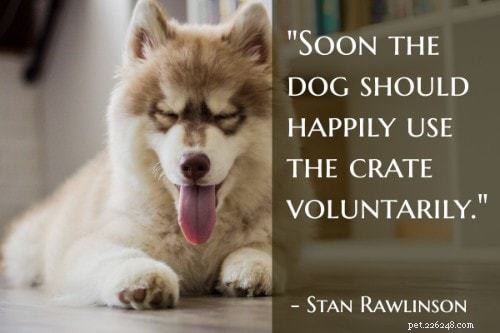
29. Gradualmente, introduza os horários de dormir engradados. “Em breve, o cão deve usar a caixa voluntariamente com prazer. Quando você chegar a este estágio, (NÃO ANTES) espere até que ele durma, então feche a porta. Fique no quarto e deixe-o sair quando ele começar a acordar. Quando seu cão estiver acostumado com essa rotina, deixe-o por um minuto depois que ele acordar (com você ainda no quarto). Gradualmente (durante cerca de uma semana) aumente o tempo em que você pode fazer isso. ” – Stan Rawlinson, Criar cachorrinhos de treinamento de maneira fácil , DogListener
30. Você ainda terá que se levantar no meio da noite. “Deixe um filhote sair de sua caixa a cada duas horas quando você começar a treinar, principalmente entre 8 semanas e 12 semanas. O site da Humane Society dos Estados Unidos diz que filhotes com menos de 6 meses de idade podem ficar em uma caixa por três a quatro horas por vez, no máximo. Isso não significa que você terá que acordar no meio da noite todas as noites por seis meses ou mais; mas você não poderá passar a noite toda por um período. Sozinho, o cão dormirá a noite toda quando sua bexiga permitir. Se ele está dormindo, ele não está desesperado para fazer xixi. Um que ele desperta, porém, ele será.” – Melodie Anne, Meu cachorro pode dormir em outro quarto em sua caixa à noite? , O ninho; Twitter: @TheNest
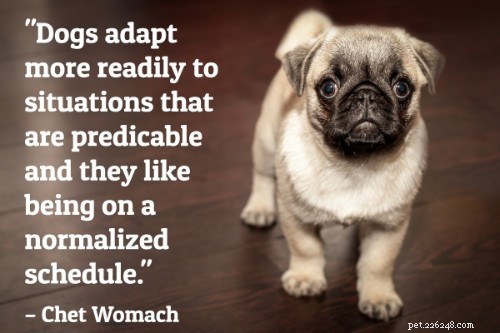
31. Corte a água antes de dormir. “Para facilitar esse processo para ambos, sugiro tomar água 2 horas antes de dormir e sair com seu filhote antes de ir para a cama à noite. Fique em um cronograma! Os cães se adaptam mais facilmente a situações previsíveis e gostam de estar em um horário normalizado”. – Chet Womach , Cachorros de treinamento em caixa , O segredo do treinamento do cão; Twitter: @DogTrainer411
32. Aderir às orientações. “Uma boa regra geral é que um cão pode ser enjaulado durante a noite e por até metade do dia, desde que suas necessidades sociais e físicas sejam atendidas enquanto não estiver na caixa. Filhotes jovens precisam de sonecas mais frequentes e oportunidades muito mais frequentes para “fazer seus negócios” do que os adultos. Uma boa estimativa de quanto tempo um filhote pode esperar antes de precisar se aliviar é quantas horas ele tem meses de idade, mais um. Assim, um filhote de três meses pode administrar por cerca de quatro horas. Durante a noite, ele geralmente consegue segurar um pouco mais, geralmente cerca de 1,5 vezes o máximo do dia – cerca de seis horas para um bebê de três meses. Mas não se esqueça de que os filhotes precisam ser completamente socializados antes dos cinco meses de idade – então essas horas acordados e fora da caixa são muito preciosas para a socialização!” – Jennifer Messer, A verdade de um treinador sobre caixas , Revista Cão Moderna; Twitter: @ModernDogMag

33. Muito tempo em uma caixa pode ser prejudicial para o seu cachorro. “[Alguns] acreditam que o confinamento prolongado pode ser prejudicial – e dizem que algumas pessoas trancam cães de estimação em pequenas caixas por até 18 a 22 horas no total por dia. Cães enjaulados demais, dizem eles, podem sofrer complicações de 'raiva de gaiola', ansiedade, medo e depressão”. – Sofija Stefanovic, Na casinha de cachorro:quando deixar seu canino na caixa se torna abuso de animais de estimação? , O guardião; Twitter: @guardian
34. Não o prepare para sentimentos de traição. “Sempre varie o tempo que seu cão passará em sua caixa, especialmente durante o treinamento. Isso evitará que seu cão 'espere' ser solto em um determinado momento e reduzirá quaisquer problemas, como choramingar ou arranhar a porta da caixa.” – Treinando seu cão na caixa , RSPCA Vitória; Twitter: @RSPCAVIC
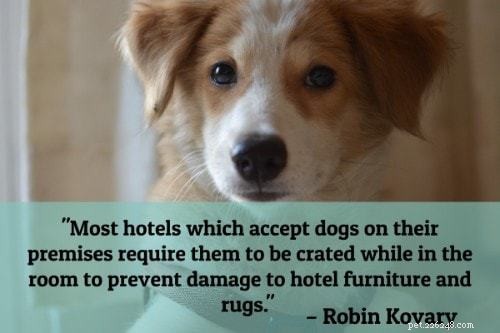
35. As caixas servem a muitos propósitos. “Uma caixa de canil também serve como uma cabine de viagem para o seu cão quando viaja de carro ou avião. Além disso, a maioria dos hotéis que aceitam cães em suas instalações exige que eles sejam encaixotados enquanto estiverem no quarto para evitar danos aos móveis e tapetes do hotel.” – Robin Kovary, Treinamento da Caixa , POLEGADAS:Canal da Internet
36. Deixe seu cachorro confortável em sua caixa. “Você também precisará equipar a caixa deles com alguma roupa de cama. Se o cão não mastigar o tecido ou sujar a cama, você pode usar uma toalha ou um cobertor leve dentro da caixa. O jornal não é uma boa ideia, pois pode enviar a mensagem de 'banico aqui', principalmente se o cachorro foi previamente treinado para ir no papel. Alguns cães vão urinar em uma caixa se for fornecida roupa de cama. Se o seu cão fizer isso, remova a roupa de cama até que o filhote comece a entender que a cama é para dormir – não para um penico!” – Treinamento de caixa e domagem fácil:adestramento de cachorrinho em casa , Dogtime; Twitter: @dogtimedotcom
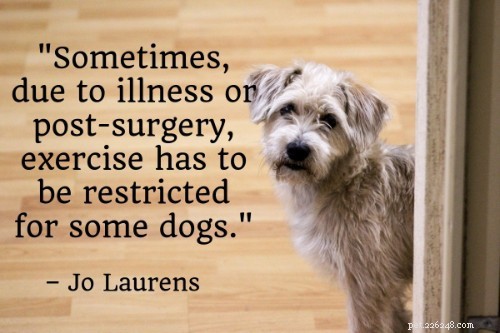
37. Às vezes, as caixas são apenas necessárias. E seu filhote não estará um passo à frente se isso acontecer? “Se seu filhote tiver que ir ao veterinário para um procedimento ou cirurgia, ele será colocado em uma gaiola de cachorro antes e depois. Se ela estiver acostumada a ficar confinada dessa maneira, ela ficará muito menos estressada antes e depois da cirurgia. Às vezes, devido a doença ou pós-cirurgia, o exercício deve ser restrito para alguns cães”. – Jo Laurens, Crate Training A Puppy – O melhor guia especializado, O site Happy Puppy
38. Crating pode ajudar durante tempos caóticos. “A grade pode até ser uma boa ideia para cães adultos na hora das refeições ou quando você tem convidados; é quando até os cães mais deliciosos podem se tornar um incômodo.” – Expectativas da caixa:adestrando seu cão na caixa , Petsmart; Twitter: @PetSmart
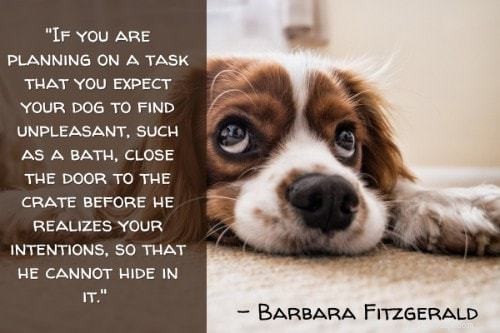
39. Nunca arraste seu cão para fora de sua caixa. “Se você está planejando uma tarefa que espera que seu cão ache desagradável, como um banho, feche a porta da caixa antes que ele perceba suas intenções, para que ele não possa se esconder nela. Você quer evitar transformar seu porto seguro em um campo de batalha com você tentando arrastá-lo para fora de sua toca.” – Barbara Fitzgerald, 5 dicas sobre treinamento em caixas:a maneira agradável de criar um cachorrinho , Pet Útil; Twitter: @PetHelpful
40. Nunca ignore o medo de ou ao redor da caixa. “[T]ente encontrar o que assusta seu filhote e elimine-o. Às vezes é a própria caixa; tente trocar de caixa para aliviar o estresse dela. Outro possível problema pode ser que você está tentando tirá-la de sua toca quando ela não quer sair. Nunca tente forçar o seu cachorro a sair. Ensine-a a deixar a caixa ao seu comando verbal. , Animais
Confira estes recursos e produtos para treinar seu filhote em uma caixa:
- Treinamento da caixa para filhotes:Treinamento para filhotes Iams®
- Treinamento da caixa
- Como engradar um cachorrinho
- Guia de treinamento para caixas positivas da Karen Pryor Academy
- Treinamento da caixa Cesar Milan Dog Whisper
- Como adestrar seu filhote de cachorro!
- Crate treinando seu cão ou filhote
- E-book de treinamento da caixa
- Treinamento em caixas:um manual de A a Z sobre como treinar um filhote de cachorro em caixas, treinar cães em caixas, cronograma de treinamento em caixas e muito mais
- Como adestrar seu cachorrinho na caixa
- Treinamento de cães:um guia passo a passo para treinamento de coleiras, treinamento de caixas, treinamento de penico, obediência e treinamento de comportamento (livros de treinamento de cães) (Volume 1)
Treinamento de obediência para filhotes
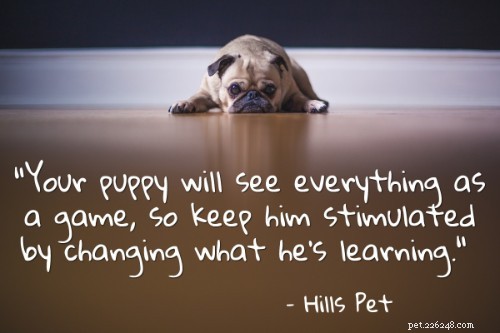
41. Mantenha breve. “Seu filhote verá tudo como um jogo, então mantenha-o estimulado mudando o que está aprendendo. Do each command for about five minutes and come back to it whenever you can.” – Teaching Your Puppy:Obedience Training Basics , Hills Pet; Twitter: @HillsPet
42. Start early and create a bond. “To establish a positive rapport with your puppy and prevent many future problems, start training a few days after your puppy settles in. A relationship based on friendship and trust will ensure that he tries hard to win you praise and approval.” – Kathy Santo, Puppy training basics, IAMS; Twitter: @IAMS
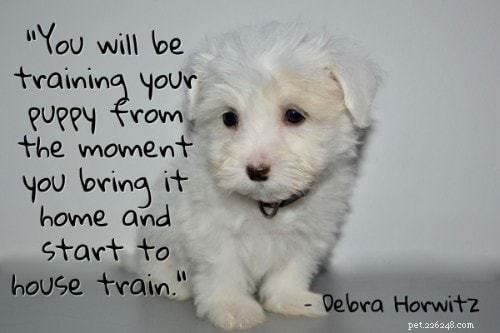
43. No, really cedo. “You will be training your puppy from the moment you bring it home and start to house train. Puppies start learning from birth and good breeders begin handling and socialization right away. Some training can begin as soon as the puppy can open its eyes and walk. Young puppies have short attention spans but you can expect them to begin to learn simple obedience commands such as ‘sit,’ ‘down,’ and ‘stay,’ as young as 7 to 8 weeks of age.” – Debra Horwitz, Puppy Behavior and Training – Training Basics , VCA Hospitals; Twitter: @VCAPetHealth
44. Training them will mitigate future behavior problems. “Dogs have their own set of behavioral problems. Lack of discipline may badly affect your dog’s behavior and turn your beloved pet into a disobedient, aggressive or unruly dog. As a dog owner you should be aware of these problems and train your dog accordingly.” – How To Train Your Dog , Train Pet Dog; Twitter: @trainpetdog

45. His name matters. “Of course you’ll want to pick a name for your new puppy or dog that you love, but for the purposes of training it also helps to consider a short name ending with a strong consonant. This allows you to say his name so that he can always hear it clearly. A strong ending (i.e., Jasper, Jack, Ginger) perks up puppy ears—especially when you place a strong emphasize at the end.” – 10 Best Training Tips , Pedigree; Twitter: @PedigreeUS
46. Proper training will make your dog a better community participant. “Dog Training for Obedience lays down a set of rules or boundaries which educates your dog to become a responsible member of society. Including how to relate to other dogs, animals and people, basic manners and how to behave in any situation.” – Dog Training For Obedience – The Key To Raising A Well Behaved Dog , Dog Training Central; Twitter: @ThePaw_com
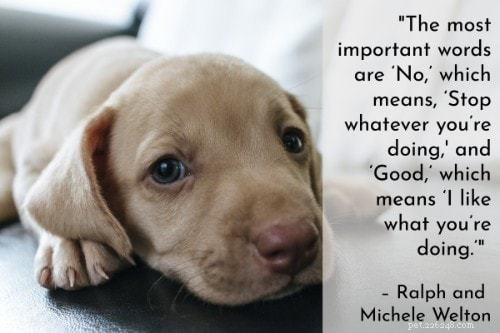
47. Work on his vocabulary. “The most important words are ‘No,’ which means, ‘Stop whatever you’re doing,’ and ‘Good,’ which means ‘I like what you’re doing.’ These praise and correction words should be started at 2-3 months of age. You must teach these words properly, with the right tone of voice and the right body language, or they won’t be of any help in teaching other words. If your puppy is older than 2-3 months and hasn’t learned ‘No’ and ‘Good’ flawlessly, you must start with those words before you can expect success with other word training.” – Ralph and Michele Welton, Puppy Training Schedule:What To Teach Puppies, and When, Your Purebred Puppy; Twitter: @yourpurebredpup
Check out our list of the Best Dog Training Collars to find the perfect training collar for your puppy.
48. Give plenty of affection. “Most people don’t have a problem being very clear about when they are unhappy with their dogs, but, they often ignore the good stuff. Big mistake! Make sure you give your dog lots of attention when he’s doing the right thing. Let him know when he’s been a good boy. That’s the time to be extra generous with your attention and praise. It’s even okay to be a little over the top.” – Traci Theis and Kellyann Conway, Top Ten Dog Training Tips, Pet Finder; Twitter: @petfinder
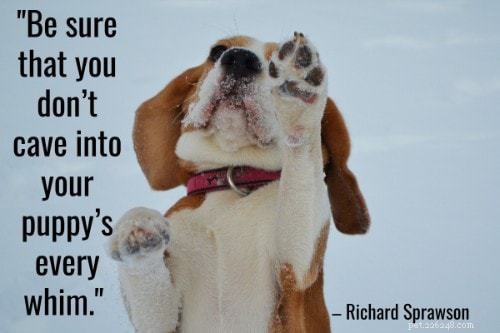
49. But don’t overwhelm the puppy. “Your new puppy has just been taken away from her mom and littermates. She is vulnerable and impressionable. What she needs now is security and routine. Play with her quietly and gently. Don’t flood her with attention and activity. If she looks like she wants to sleep, leave her alone. Puppies need lots of sleep.” – Training Puppy the First Week, Perfect Paws
50. Know your dog’s personality. “Intuitively, we all know that our dogs are like no others. They react hilariously to the most benign and everyday of sounds, or they sleep on their backs trying to copy the humans they watch daily. But, it’s not uncommon to totally forget how unique our dogs are when it comes time to do some training. Fittingly, despite some opinions to the contrary, there is no one holy grail method of training. Get to know your dog’s personality and you’ll have the keys to effective training sessions.” – Rosalee Kaschel, How Your Dog’s Personality Affects Training , PetSafe; Twitter: @PetSafe
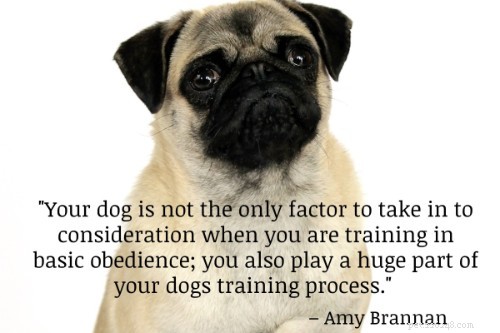
51. Factor in you , too. “Your dog is not the only factor to take in to consideration when you are training in basic obedience; you also play a huge part of your dogs training process. If you are considerably impatient or easily frustrated then you are going to want to approach teaching your dog obedience in short lessons that focus on one command at a time. You can also benefit from enrolling in a small obedience class that will allow you a reprieve if you are feeling overwhelmed.” – Amy Brannan, Dog Obedience Tips:Patience Is Key , Canine Journal; Twitter: @CanineJournal
52. Train yourself. “Most owners mistakenly believed they need to have their dogs trained when in fact the owners need the education more than the dog do. The most important component in any successful relationship between dog and owner is that the owner understands the dog and that the dog understands the owner.” – Matthew Kinneman, Puppy Obedience Training Tips The Top Ten Mistakes Owners Make , Vitamins For Pitbulls; Twitter: @bullymax
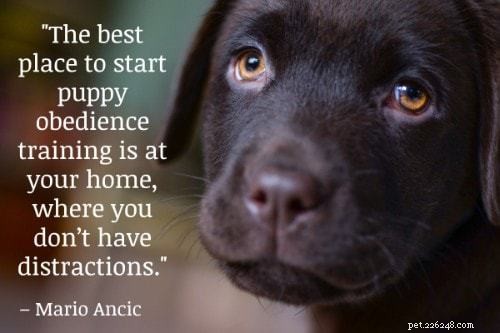
53. Start at home. “The best place to start puppy obedience training is at your home, where you don’t have distractions and where your puppy is familiar, so we can avoid the environmental stress factor that happens when a dog is in a new and unfamiliar place. Remember your puppy is in the learning phase, later on during our next steps we will add different stress factors and distractions.” – Mario Ancic, Puppy Obedience Training…Where It All Begins , Training Your Dog and You
54. Remember your dog wants to please you. “Understanding more about how a dog thinks and what is ‘normal’ for your dog will help you. It is important to remember that, for the most part, our dogs are keen to please – so if they are not doing as you ask, it may be because you are not being clear about what you want or are not using rewards, commands and body language in a way your dog understands.” – Dog Obedience Training, Purina; Twitter: @Purina
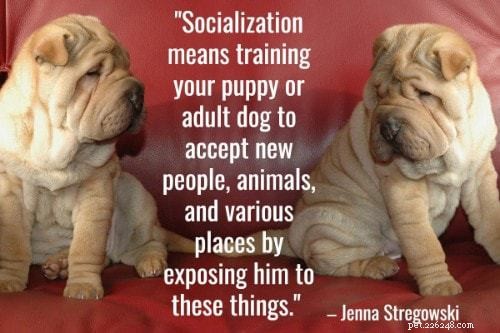
55. Socialize your puppy early. “Socialization means training your puppy or adult dog to accept new people, animals, and various places by exposing him to these things. Socialized dogs are less likely to develop behavior problems and are generally more welcomed by others. Socialization can also help prevent the development of fears and phobias. The bottom line is that socializing your dog or puppy will make him a happier, more well-behaved dog.” – Jenna Stregowski, 10 Steps To Train Your Dog , The Spruce Pets; Twitter: @JennaDogs
56. Start with basic commands. “To start, force yourself to slow down and focus on one command at a time with the plan to work through all of the basics, which include:sit, stay, heel, down, kennel and place.” – Tom Dokken, 4 Tips for Dog Obedience Training , Gun Dog; Twitter: @GunDogMag

57. Stay firm. “This is where you learn how to show your dog that you are the one in charge, that you are the alpha leader and that you are the person they need to listen to you. This will make training your puppy a lot easier. As your puppy grows, so will his need to assert himself. Be sure that you don’t cave into your puppy’s every whim.” – Richard Sprawson, Beagle Puppy Obedience Training Tips And Methods , Beagles In My Kitchen; Twitter: @rgs112
58. There are no shortcuts. “Be careful of advertisements for 10 minute puppy obedience training programs and the like. There are no miracle cures in puppy training.” – Puppy Obedience Training – How to Care for a Puppy , Shiba Shake
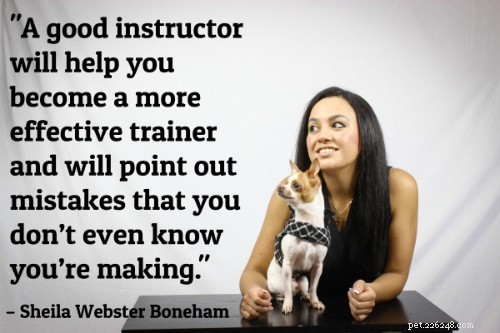
59.Consider enrolling in a good obedience class. “A class environment provides for some of the socialization your dog needs and teaches him to respond to you even with exciting distractions all around. A good instructor will help you become a more effective trainer and will point out mistakes that you don’t even know you’re making.” – Sheila Webster Boneham, How to Find a Good Dog Trainer and Obedience Class, Nylabone; Twitter: @nylabone
60. Mentally prepare for the bad days. “Not every training day is going to be perfect, but don’t get frustrated and don’t take it out on your dog. Adjust your own behavior and attitude to encourage your dog’s ability and confidence to learn. If you have a calm mood, generally your dog will, too. If the dog becomes afraid of your bad mood, he will not learn anything new. He’ll only learn to be wary and not trust you.” – How to Train a Dog , WikiHow; Twitter: @wikiHow
Check Out These Resources and Products for Puppy Obedience Training:
- Obedience Training for Dogs
- Dog Obedience:Getting Your Pooch Off the Couch and Other Dog Training Tips
- How to teach ANY dog to Come when called!
- Obedience Schools Near Me
- Introduction to Dog Training
- How To Teach Any Dog PERFECT Obedience! (Sit,Down,Stand)
- How to Stop the 10 Most Common Dog Obedience Problems
- The Power of Positive Reinforcement:The Key to Unleashing Your Dog’s True Potential
- Dog Training Academy:Obedience Training For Dogs
- What’s Good About Dog Training EBooks?
- Puppy training:Train your puppy in obedience, potty training and leash training in record time
- Zak George’s Dog Training Revolution:The Complete Guide to Raising the Perfect Pet with Love
- BKLN Manners:Positive Training Solutions for Your Unruly Urban Dog
- Pet Botanics Training Reward
- Dog Treat Bag –Training Pouch for Small and Large Dogs with Clicker and Collapsible Food Bowl
Leash Training a Puppy

61. Make a connection first. “If we had just met and you wanted to take a walk with me, how comfortable would we be together at first? We most likely would be a bit guarded with one another until we knew each other better. The same is true for a relationship between a dog and their human. […] Get to know your dog and let him get to know you, too. Work on reinforcing eye contact every time you say his name – which is most likely a brand new name for your dog. Say the name or make a noise to get his attention, and when he looks at you, say YES! and toss him a good treat. Eye contact and acknowledgement that you are seeking his attention is the first step of all training, so you really can’t do too much of this.” – Annie Phenix, How to Train Your Dog to Walk Nicely On Leash , Lucky Puppy Magazine; Twitter: @myluckypuppy
62. Leash training is a critical part of maintaining your dog’s safety and promoting your bond. “Learning how to walk properly on leash makes it safer for your pet and more enjoyable for both of you (ever seen someone fighting to keep their leashed dog under control, while it drags them relentlessly down the street? Doesn’t look like much fun…). Remember that cute little balls of fluff are still very young and their attention span can be short, so patience is a must when it comes to leash training your puppy. Positive reinforcement is important – reward your puppy for every little thing he does right during your puppy training sessions.” – Puppy Leash Training Tips , Scampering Paws
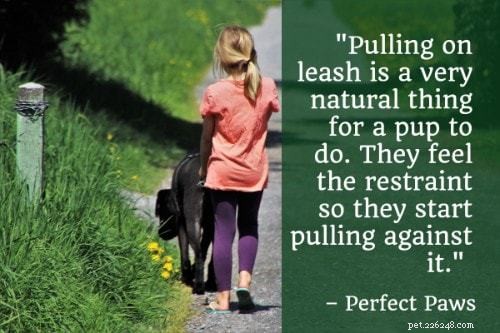
63. Give it a few trial runs before going outside. “Pulling on leash is a very natural thing for a pup to do. They feel the restraint so they start pulling against it. Let’s start the puppy leash training indoors with no distractions. Accustom the puppy to walking on a loose leash at your side. It’s important that you teach your puppy to walk on one side only. The standard is your left hand side. It really doesn’t matter which side, but choose only one and stick with it – this way your puppy won’t be tripping you up by changing sides.” – Puppy Pulling On Leash, Perfect Paws
64. Make sure your dog associates fun things with the leash. “Fill an interactive toy with food and freeze overnight. Now, attach a leash to your dog’s harness and let your dog drag it around the house for a bit. To make this experience positive and to keep a puppy from chewing on the leash, give your dog a frozen food stuffed toy to enjoy while wearing and dragging his leash around the house. Once your dog has finished his food stuffed toy, remove the leash and put it away. Practice this game several times a day. You can certainly fill interactive toys with your dog’s daily meals for more leashes-make-fun-things-happen moments. Remember, you’re not holding the other end of the leash. Your dog is learning that attached leashes are harmless and make good things appear like food stuffed toys. Practice for 3-4 days before moving onto the next step.” – Fanna Easter, What to Do When Your Puppy Won’t Walk on Leash , Dog Training Nation; Twitter: @DogTrainNation
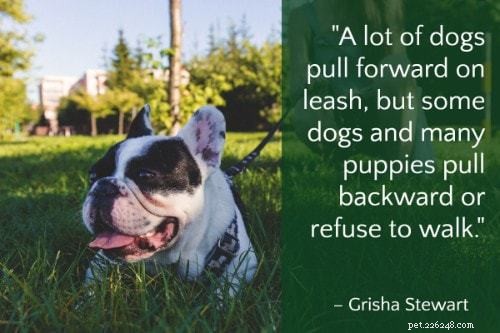
65. Your dog may be extra stubborn. “A lot of dogs pull forward on leash, but some dogs and many puppies pull backward or refuse to walk. This happens to French Bulldogs and English Bulldogs all the time! Pulling harder or luring with a treat only makes the problem worse.” – Grisha Stewart, What to Do When a Dog Refuses to Walk , Ahimsa Dog Training; Twitter: @grishastewart
66. For dogs who pull back or away, stay away from retractable leashes. “When Sunshine [the dog] pulls on the leash it doesn’t make the walk enjoyable for her guardians or the dog. The guardians had used a retractable leash, which allows Sunshine a lot of freedom. But if you have a dog that is not well behaved on the leash this additional amount of freedom can contribute to the problem. If your child is not the best driver, you wouldn’t to give it more unsupervised driving privileges; you would go back to basics and have the child practice more in a structured environment to build up the skills necessary to be a good driver. This same principal applies to your dog walking on the leash.” – Sam Kanouse, Great Leash Training Tips to Stop a Golden Retriever Puppy from Pulling on the Leash , Dog Gone Problems; Twitter: @DogGoneProblems
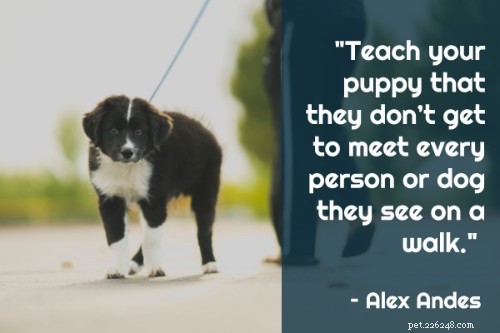
67. You must teach your puppy he can’t meet everyone. “Teach your puppy that they don’t get to meet every person or dog they see on a walk. I cannot emphasize the importance of this enough. Leash reactivity (barking, lunging, growling on leash) is the most common behavior problem I work with. In the majority of cases, it results from the dog’s frustration with being unable to get to the other dog.If we teach puppies from a very young age that walks are structured, require focus on the owner, and aren’t a social hour, it can help your puppy grow up to have reasonable expectations when seeing another dog on leash. Even with ‘social butterfly’ puppies, we don’t greet every dog we pass. When we do greet a dog or person, I teach them to sit and make eye contact with the person walking them before they are released for a brief greeting. This type of structure is critically important in order to have a dog that’s friendly and social – but also has self-control.” – Alex Andes, 5 Little-Known Puppy Training Tips You’ll Be Glad You Found , Peach on a Leash
68. Remain Calm. “Try to start all walks in a relaxed state. Often dogs get very excited to see a leash. They know it possibly means they’ll be allowed to go out and explore. Introduce the leash when your dog is calm and keep a relaxed attitude yourself throughout the entirety of your walk” – Napa ‘ze Dog, Tips for Leash Training a Puppy , Napa’s Daily Growl; Twitter: @NapatheDog

69. Use the proper gear. “Practice with a 6-foot regular leash that is long enough to create some slack. Always use a flat buckle collar or harness. No choke chains, prong collars, and definitely no shock collars.” – Sharon Dianora, Leash Training a Puppy To Walk Calmly , Dog Care Knowledge; Twitter: @Dogcareknow
70. Let him hit the jackpot! “Remain calm at all times, and utilize jackpots (more treats or better treats) when your dog accomplishes something that was difficult for him; i.e., not pulling you toward the neighbor dog! Jackpot for any eye contact or focus on you! Keep leash training sessions short and FUN! You can train several times a day, but you don’t want to push you or your dog past the point of fun! Puppies, especially, have short little attention spans, and if you insist on puppy training past the point of fun – usually around five minutes – your pup may start to dislike, and dread training!” – Leash Training Tips To Stop The Pulling And Enjoy Your Walks Again , The Dog Training Secret; Twitter: @DogTrainer411
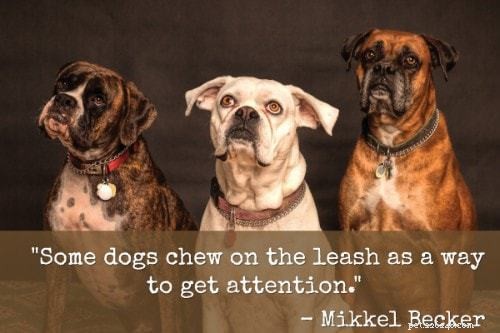
71. If he’s chewing on his leash, he may be over stimulated or desperate for attention. “Some dogs chew on the leash as a way to get attention. When your dog is walking calmly on a loose leash, no one pays attention to him, but when he acts out, the focus shifts directly to him. For many dogs, negative attention is better than no attention at all. Other dogs are over-aroused, and the easiest way to release tension is to bite on the leash. In the shelter situation, dogs frequently grab and chew on the leash, often when first taken out of the kennel and led with other dogs. The more intense the situation and the more wound up a dog is, the more likely that leash biting will occur.” – Mikkel Becker, Put a Stop to Leash Chewing and Tugging, Vet Street; Twitter: @Vetstreet
72. Not all dogs get the same gear. “A front-attachment harness is a safe and easy to use no-pull device that is great for all dogs. Choose a head collar for dogs with aggressive tendencies or for those that need the maximum amount of control such as a small owner with giant-breed dog. The front-attachment harness and head collar should only be used with leashes that are a maximum of six feet long. If the leash is too long, it is possible that he could get going fast enough to hurt himself if he were to hit the end of the leash abruptly.” – Jessica Rollins, Leash Training:How to Walk a Dog That Pulls , Pet Expertise; Twitter: @PetExpertise

73. Even if it’s worked in the past; that doesn’t mean that’s the method you should stick with. Some puppies are more resilient than others and can learn to walk on a leash despite the method. “My general rule of thumb is that we should use methods that focus on rewarding the correct behavior, starting with steps the dog can easily perform and quickly moving on to steps that are closer and closer to our goal behavior; rather than methods that rely on sheer luck that the type of dog you selected can endure it mentally unscathed. And if we choose methods that are as crude as dental care in the 16th century, we should realize that some dogs learn no matter what we do to mess them up.” – Dr. Sophia Yin, My Puppy Won’t Walk on Leash! 3 Ways to Train Your Puppy to Love Her Leash , Cattledog Publishing, the Legacy of Dr. Sophia Lin; Twitter: @SophiaYin
74. Treat well and treat frequently. “Keep your dog’s leash short enough that he cannot easily leave your side, thereby modeling the position you want him to be in. Don’t keep it so short that you’re dragging him, though. Simultaneously lure him into the correct area by your side with tiny treats. You can mark the behavior with a word or clicker if you like. When he starts to get the idea, stop luring but do reward him for staying by your side. Give a treat every few steps at first, increasing the distance you walk between treats until he forms the habit of walking at your side without treats. You can also give him a bit more leash as long as he doesn’t weave or circle.” – Teaching Your Dog to Walk on a Leash , Nylabone; Twitter: @nylabone
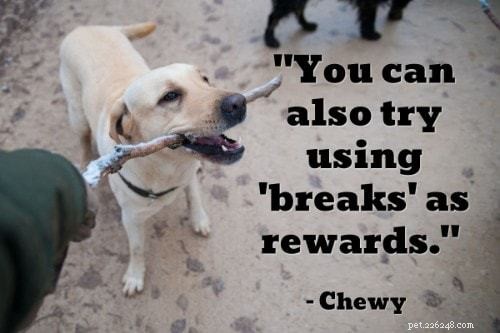
75. Rewards are more than just treats. “You can also try using ‘breaks’ as rewards. For instance, if (or, more likely, when!) he wants to sniff around, ‘Ask for a sit or eye contact first, then let him sniff and ‘be free’ for a bit, before walking nicely again,’ advises Mayer.” – How to Leash Train a Dog , Chewy; Twitter: @Chewy
76. Don’t start to early and don’t skip the home training. “I recommend waiting until they’re 10 weeks old. This is because until 12 weeks old, they’ve no need for ID tags as they’re just too young to take outside further than your back yard while they complete their vaccination program. And during house training you don’t need to lead them outside, they’re so small at this age that you can simply scoop them up and carry them. But by getting them used to a collar and leash at 10 weeks old, they will be comfortable wearing them by 12 weeks when you can start to walk them outside.” – LTHQ, How To Get Your Puppy Used To A Collar And Leash , Labrador Training HQ; Twitter: @LabTrainingHQ
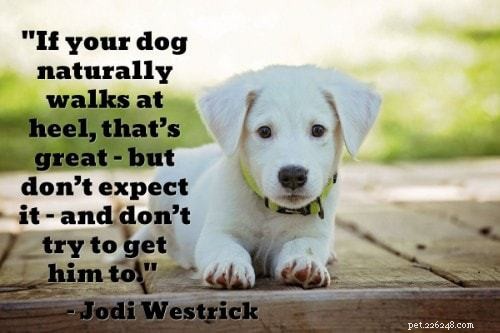
77. Get down to his level. “If your dog naturally walks at heel, that’s great – but don’t expect it – and don’t try to get him to. Yanking on the leash won’t help the situation, so think of getting him to walk as a gradual process. You may need to stand still or kneel down while he figures out what’s going on – that way your pup realizes that he won’t be able to go anywhere unless it is by your side. Some dogs may decide to sit down and not move. If this happens, call to your pup and offer him a reward when he comes over. Never yank him toward you. Once he comes over of his own will, offer him a treat and continue walking with him by your side.” – Jodi Westrick, How to Leash Train Your Active Puppy , Animal Planet; Twitter: @AnimalPlanet
78. Imposing penalties. “Here’s a terrific exercise. Set up a goal for your dog – it could be a biscuit on the ground, or a person she adores. With your dog on leash, take a step toward her goal. The instant she draws forward and tightens the leash, say, ‘Oops!’ and go right back to the starting point. Repeat, repeat, repeat, imposing penalty yards whenever your dog draws the leash tight. I did mention you’d need patience, didn’t I? Help your dog succeed by delivering treats as she keeps the leash loose on the way to the goal.” – Jolanta Benal, Teach Your Dog to Stop Pulling the Leash , Quick and Dirty Tips; Twitter: @quickdirtytips
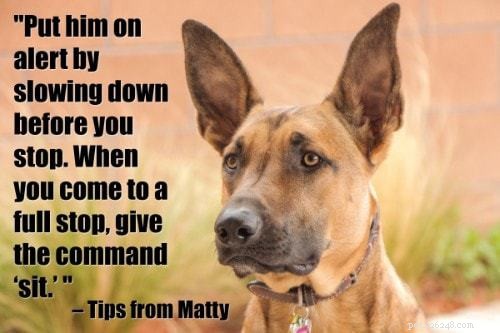
79. Don’t forget to teach him to sit at your side when you stop. “The procedure for teaching your dog to automatically sit when you stop walking is a simple one. Put him on alert by slowing down before you stop. When you come to a full stop, give the command ‘sit.’ If necessary, slowly pull us on the leash and push down on his haunches. […] When he does sit, praise him for obeying. Eventually, it will not be necessary to use the ‘sit’ command.” – Tips from Matty, Teaching your Dog to Heel and Sit , PBS; Twitter: @PBS
80. Repeat, repeat, repeat – and you’ll get it. “To make sure that your canine has the leash and collar routine down pat, you need to repeat this training in many different settings, and at many different places. Fortunately, leash training isn’t the most difficult dog training trick you’ll have to teach your dog, and it’s fairly easy to get ahold of this. You can even combine leash training with ‘stranger’ training. Just make sure you do them separately in the your home first.” – Samantha Randall, 3 Tips to Effectively Leash Train Your Dog , Daily Treat; Twitter: @RoverDotCom
Check Out These Resources and Products for Leash Training Your Puppy:
- How to Leash Train a Puppy:Iams® Puppy Training
- Little Dog – Leash Walking
- Leash Training
- How to Train Your Dog to NOT PULL on the Leash!
- Managing a leash-reactive dog
- 10 Quick Tips for Leash Training Your Dog
- The Best Collars and Leashes for Puppies and Dogs
- How to Give Your Dog a Good Leash on Life
- Whole Dog Journal Guide To Collars &Leashes
- Dog Leash Training eBook
- DOGS UNLEASHED:From On-Leash To Off-Leash:Complete Leash Training for Dog Lovers (New Dog Series)
- Puppy Leash Training Instruction:How to Train a Puppy to Walk On a Leash
- Dog Training:Leash Training, Potty Training, Crate Training And Behavior
- Let’s Go!:Enjoy Companionable Walks with your Brilliant Family Dog (Essential Skills for a Brilliant Family Dog)
Puppy Clicker Training
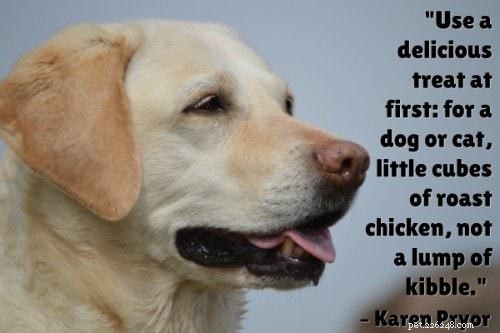
81. Know the proper clicker training procedure. “Push and release the springy end of the clicker, making a two-toned click. Then treat. Keep the treats small. Use a delicious treat at first:for a dog or cat, little cubes of roast chicken, not a lump of kibble.” – Karen Pryor, Fifteen Tips for Getting Started with the Clicker, Karen Pryor Clicker Training; Twitter: @karen_pryor
Check out our list of the Best Dog Training Treats for the perfect treats to use for clicker training.
82. A clicker isn’t a remote. “Do not point it at your dog. Instead put your hand behind you back or keep it to your side and click whenever your pet is doing the right thing. Dogs are visually oriented animals, this means that they will use any body cue you give them. You want them to respond to the ‘sound’, not your arm movement!” – 23 Free Dog Clicker Training Tips for Best Results , Dog Training Excellence; Twitter: @DogExcellence
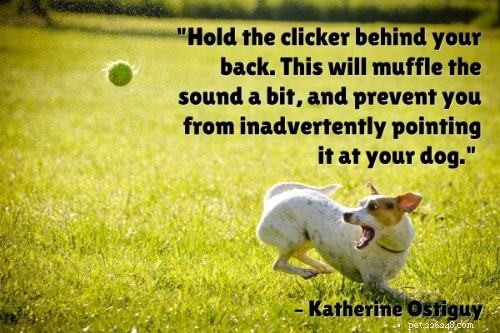
83. If the clicker scares your dog, find a way to soften it. “Hold the clicker behind your back. This will muffle the sound a bit, and prevent you from inadvertently pointing it at your dog. (Remember, it’s not a remote control!) If that’s not enough, you can wrap the clicker in layers of soft fabric to muffle the sound even more. One of my clever clients wrapped her clicker in baby socks. Every few days, she could take one sock off, so the sound gradually became a bit louder. It worked perfectly! After a couple of weeks, they were able to take the socks off the clicker and click ‘normally.’ You can also try these techniques with a ‘clicky pen‘ (one with a button on the end that you have to ‘click’ to start writing and ‘click’ to stop) and see if your dog is more tolerant of that. If she is, use that for the first couple of weeks and then reintroduce the clicker.” – Katherine Ostiguy, Fear of the Clicker:How to Train Your Dog Through It , Spring Forth Dog Academy; Twitter: @springforthdog
84. Start by charging up the charger with you dog. “Click the clicker once (in-out) and give your dog a treat (press on the end of the metal tab that does not have the dimple). Hint:Use something your dog really likes at first. Small pieces of yummy food (dog cookies, hot dogs, cheese) are best because the dog can enjoy it and be ready for the next thing quickly. Repeat this until your dog reacts to the clicker (by startling, pricking her ears, or suddenly looking for the treat). If she does, you’re ready for the next step… Hint:Try to keep your timing random (1-5 seconds between one click-and-treat time and the next). Technical Note:This is called ‘establishing a secondary reinforcer’ but most people call it ‘charging up the clicker’! Remember, click first, then treat.” – Stacy Braslau-Schneck, Get Started With Clicker Training, Wag’n’Train
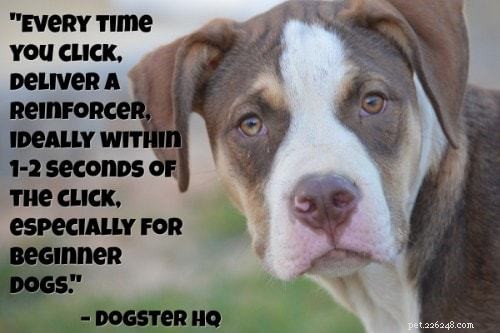
85. Treats mean reinforcements. “Every time you click, deliver a reinforcer, ideally within 1-2 seconds of the click, especially for beginner dogs. Think of the clicker like your dog’s paycheck – clicking without treating is like having your paycheck bounce at work…would you go back to work on Monday?” – Dogster HQ, Dog Clicker Training Basics , Dogster; Twitter: @dogster
86. Work on your timing. “Much of clicker training is mechanical skills, such as food delivery and clicker timing. You can work on improving your timing and accuracy without your animal. For example, watch the news and try to click whenever anyone says the word ‘today.'” – Mary Hunter, 10 Tips to Improve Your Clicker Training, Stale Cheerios; Twitter: @cheeriotrainer
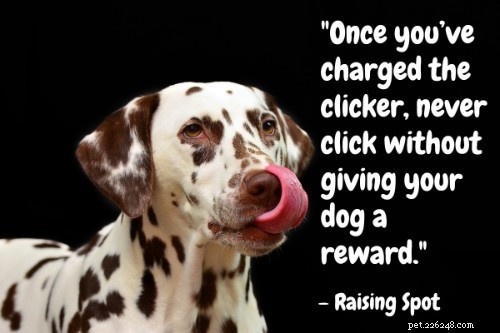
87. Every click is a treat. “Once you’ve charged the clicker, never click without giving your dog a reward. Clicker training depends on your dog trusting that a reward will come when he hears the marker. If you’re inconsistent, your dog won’t make an effort to remember the behavior that prompted the click.” – Tips for Successful Clicker Training , Raising Spot
88. The clicker is an audible alert letting your puppy know what’s coming. “So the clicker just lets your dog know that they did what you wanted them to do and it also lets them know that a treat is coming, because we’re going to be doing positive reinforcement training today.” – Clicker Training for Dogs:Wag! 2-minute Training Treats , The Daily Wagger; Twitter: @WagWalking
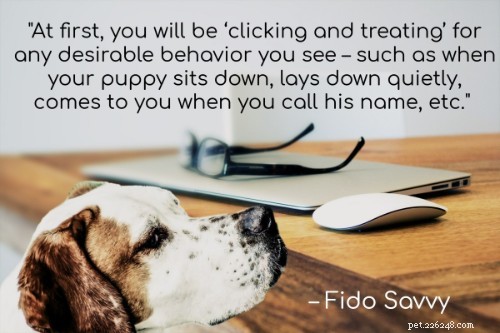
89. In the beginning, click for everything. “At first, you will be ‘clicking and treating‘ for any desirable behavior you see – such as when your puppy sits down, lays down quietly, comes to you when you call his name, etc.” – All About Puppy Clicker Training, Fido Savvy
90. Use clicker training consistently and your dog will be able to learn more. “Clicker training at the beginning is an example of classical conditioning. If used consistently it can become operational conditioning, where the dog intentionally repeats an action to gain a reward. The difference might seem minor but it has big implications on the behavior of your dog. If your dog is performing actions with a purpose rather than by habit he’s going to retain much more information.” – Jen Gabbard, How to Get Started With Clicker Training Your Dog , Puppy Leaks; Twitter: @puppyleak
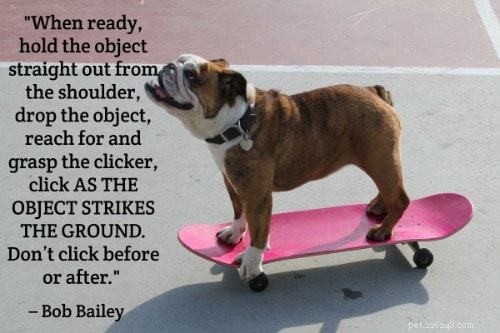
91. Practice makes perfect. “Stand next to a table. Place a clicker on the table where your right or left hand can reach it comfortably without your looking. Now, in your right or left hand (the one away from the clicker side), hold a bunch of keys, a ball, or some other fairly dense object. When ready, hold the object straight out from the shoulder, drop the object, reach for and grasp the clicker, click AS THE OBJECT STRIKES THE GROUND. Don’t click before or after. If you can, have someone else watch and judge your timing, or videotape. As a variation, when you get good (10 out of 10), begin to lower the dropping hand to shorten the time between release and hitting the floor. That is just a start. When you get that down pat, switch the hand that drops the object to the CLICKING HAND. Thus, if you click with the right hand, hold out the right hand with the object, drop it, reach with that same hand to get the clicker and click just as the object hits the ground. When you can do that 8 out of 10 times you are pretty good.” – Bob Bailey, Improving Timing , Clicker Solutions
92. Don’t speak. They know just what you’re saying. “One of the easiest things to start with is to teach them to touch an obvious target, like a mat on the floor, a ball on a stick or your hand. As your pet approaches the target, click and treat. You don’t have to wait until they touch it because you’re shaping their behavior and rewarding small steps towards the end goal. At this stage let the clicker speak for itself – if you say anything it could be distracting.” – Clicker Training Your Pet , Blue Cross for Pets; Twitter: @The_Blue_Cross
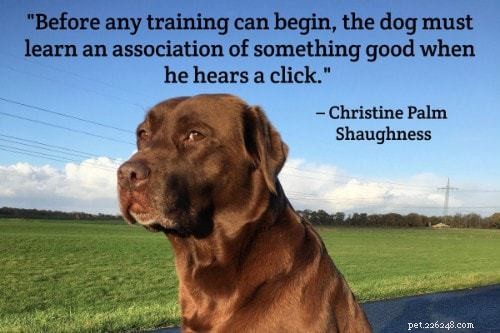
93. Keep charging your clicker during training. “One of the biggest problems with clicker training is the lack of understanding of why and how to use the clicker. I recently met a novice trainer who didn’t know that the clicker needed to be ‘charged,’ that is, before any training can begin, the dog must learn an association of something good when he hears a click. After all, the sound of the click by itself is meaningless. ‘Charging’ the clicker involves simply clicking and immediately giving the dog a high value treat. Click and treat, click and treat. Do this about 20-30 times. The dog is sure to learn that whenever he hears the click, it’s a good thing!” – Christine Palm Shaughness, Clicker Training for Dogs, Capers for Canines (and Other Animals)
94. Clicker training is so much faster. “An advantage to using the clicker is that the reward is instantaneous. You can press the clicker much more quickly than you can give the dog a treat or even say ‘good boy.’ As soon as the dog starts the good behavior, immediately click. That way, it’s completely clear to the dog what you are rewarding.” – Megan Smith, Clicker Training Pros &Cons , Daily Puppy; Twitter: @DailyPuppy
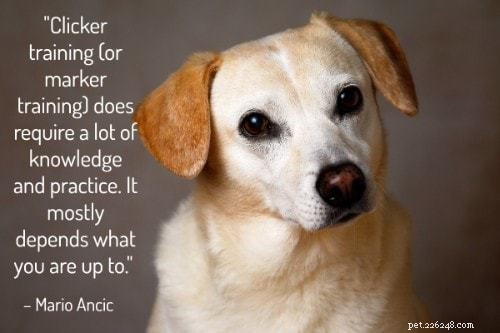
95. The more advanced the technique, the more skilled your clicking will need to be. “Clicker training (or marker training) does require a lot of knowledge and practice. It mostly depends what you are up to. With basic exercises you can get away with not such great timing, however with more advanced exercises it is important that you have a good eye-hand coordination.” – Mario Ancic, Pros and Cons of Clicker Training , Training Your Dog and You
96. Don’t ignore any bad behaviors during clicker training. “How to eliminate behaviors you don’t like:Establish a ‘no reward’ signal, like ‘oops’ or ‘too bad.’ Positively reinforce an incompatible behavior (a reliable ‘sit’ will prevent your puppy from jumping up). Time-outs:Immediately after a misbehavior, turn away and ignore the puppy for 30 seconds to a minute.” – Clicker Training – First Steps , Animal Hospital of North Asheville; Twitter: @AHNApets
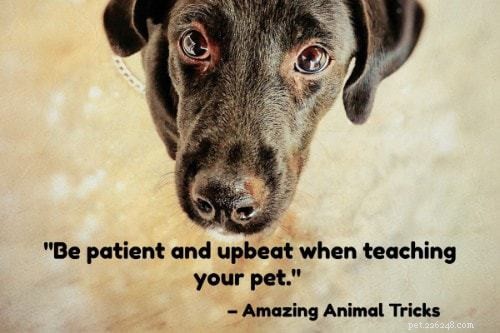
97. Click even for small progress. “Click when the animal offers small steps in the right direction. Animals learn most behaviors in small steps; they do not have to perform the behavior perfectly at first. Be patient and upbeat when teaching your pet.” – Clicker Training, Amazing Animal Tricks
98. Transitioning away from food rewards. “What many people do not realize about dog clicker training is that the ultimate goal is to be able to get certain behaviors from your dog reliably without having to have a clicker and a treat bag in your hand. It is important to learn how to transition away from dependence on the clicker system once a behavior is learned and you have added distance, duration and distraction. […] Return to a food reward refresher from time to time:This helps keep your dog sharp on behaviors that you have trained. There is no harm in practicing well known behaviors with a rapid reward in the context of a training session. This will only help your dog stay confident in a training session as well as keep them sure about commands they learned long ago.” – Mat, Clicker Training Basics 7 Insanely Actionable Steps , Wiley Pup; Twitter: @wileypupwebsite
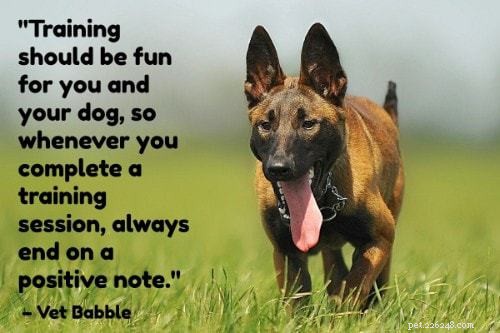
99. End on a high note. “Training should be fun for you and your dog, so whenever you complete a training session, always end on a positive note. If you are both getting frustrated, ask your dog to do something he knows how to do and reward him for that. Never end on a failure. The following video has some great training advice and features the clicker and how to shape behaviors.” – Cool Dog Tricks To Teach Your Furry Friend , Vet Babble; Twitter: @VetBabble
100. Worst case scenario is it won’t work if not done properly. “Clicker training is recommended by the American Veterinary Society of Animal Behavior as well as the Humane Society of the United States. There are no negative side effects. The worst that can happen is training will be ineffective if applied incorrectly.” – Clicker Training Basics , Fortunate Fido
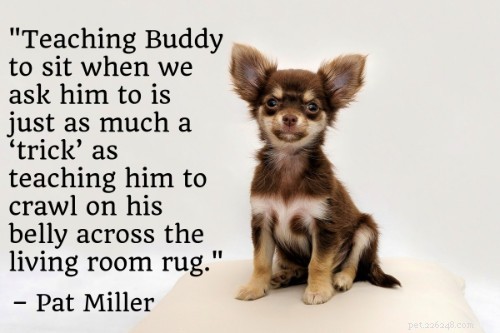
101. It’s all tricks! “Positive trainers have a saying that I love. We like to remind our clients that, ‘It’s all tricks!’ Teaching Buddy to sit when we ask him to is just as much a ‘trick’ as teaching him to crawl on his belly across the living room rug. They are both simply behaviors that Buddy is physically capable of doing, that we teach him to offer us in response to a verbal cue or hand signal. If we can change our attitude and remember to have fun teaching the basics as well as the tricks, we can have a dog who performs the serious behaviors with just as much enthusiasm as he does when he rolls over or catches a treat off the end of his nose.” – Pat Miller, Clicker Training and Trick Training Your Dog , Whole Dog Journal; Twitter: @WholeDogJournal
Need more training advice? Make sure to check out our helpful pet training articles.
Check Out These Resources and Products for Clicker Training your Puppy:
- The Wonder of Clicker Training:The Complete Guide to a Nonviolent, Positive, Compassionate, &Effective Way of Dog Training with Clickers
- Understand THIS and Your Dog Will Learn Faster (How to Achieve Perfect Timing!)
- Clicker Training 101
- Super Cooper Sunday #2 – Clicker Training Explained (Golden Retriever Puppy)
- Best Pet Clicker Trainers
- Clicker Training for Dogs
- Is There Something Special About Clicker Training for Dogs?
- Clicker Training Dogs
- Clicker training – Wikipedia
- Clicker Training for Dog Lovers
- A Simple Guide on How to Train Your Dog:Use Clicker Training to Teach Your Dog to Walk on a Leash, Sit, Stay, Go to Potty and Obey Your Commands
- EcoCity 2018 Pet Training Clicker Set (4 Pack)

